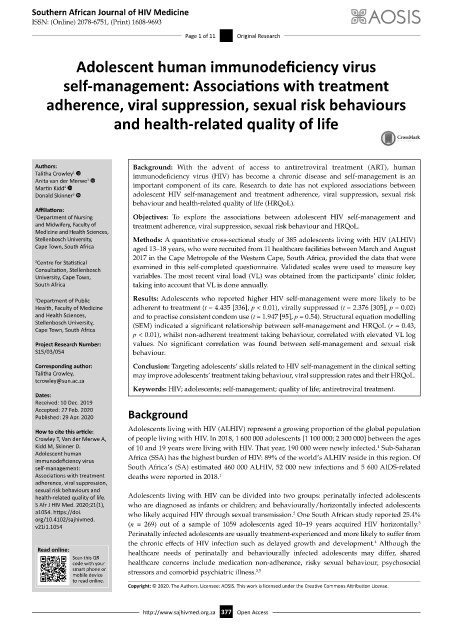Page 385 - HIVMED_v21_i1.indb
P. 385
Southern African Journal of HIV Medicine
ISSN: (Online) 2078-6751, (Print) 1608-9693
Page 1 of 11 Original Research
Adolescent human immunodeficiency virus
self-management: Associations with treatment
adherence, viral suppression, sexual risk behaviours
and health-related quality of life
Authors: Background: With the advent of access to antiretroviral treatment (ART), human
Talitha Crowley 1 immunodeficiency virus (HIV) has become a chronic disease and self-management is an
Anita van der Merwe 1
Martin Kidd 2 important component of its care. Research to date has not explored associations between
Donald Skinner 3 adolescent HIV self-management and treatment adherence, viral suppression, sexual risk
behaviour and health-related quality of life (HRQoL).
Affiliations:
1 Department of Nursing Objectives: To explore the associations between adolescent HIV self-management and
and Midwifery, Faculty of treatment adherence, viral suppression, sexual risk behaviour and HRQoL.
Medicine and Health Sciences,
Stellenbosch University, Methods: A quantitative cross-sectional study of 385 adolescents living with HIV (ALHIV)
Cape Town, South Africa aged 13–18 years, who were recruited from 11 healthcare facilities between March and August
2017 in the Cape Metropole of the Western Cape, South Africa, provided the data that were
2 Centre for Statistical
Consultation, Stellenbosch examined in this self-completed questionnaire. Validated scales were used to measure key
University, Cape Town, variables. The most recent viral load (VL) was obtained from the participants’ clinic folder,
South Africa taking into account that VL is done annually.
3 Department of Public Results: Adolescents who reported higher HIV self-management were more likely to be
Health, Faculty of Medicine adherent to treatment (t = 4.435 [336], p < 0.01), virally suppressed (t = 2.376 [305], p = 0.02)
and Health Sciences, and to practise consistent condom use (t = 1.947 [95], p = 0.54). Structural equation modelling
Stellenbosch University, (SEM) indicated a significant relationship between self-management and HRQoL (r = 0.43,
Cape Town, South Africa
p < 0.01), whilst non-adherent treatment taking behaviour, correlated with elevated VL log
Project Research Number: values. No significant correlation was found between self-management and sexual risk
S15/03/054 behaviour.
Corresponding author: Conclusion: Targeting adolescents’ skills related to HIV self-management in the clinical setting
Talitha Crowley, may improve adolescents’ treatment taking behaviour, viral suppression rates and their HRQoL.
[email protected]
Keywords: HIV; adolescents; self-management; quality of life; antiretroviral treatment.
Dates:
Received: 10 Dec. 2019
Accepted: 27 Feb. 2020 Background
Published: 29 Apr. 2020
How to cite this article: Adolescents living with HIV (ALHIV) represent a growing proportion of the global population
Crowley T, Van der Merwe A, of people living with HIV. In 2018, 1 600 000 adolescents [1 100 000; 2 300 000] between the ages
Kidd M, Skinner D. of 10 and 19 years were living with HIV. That year, 190 000 were newly infected. Sub-Saharan
1
Adolescent human Africa (SSA) has the highest burden of HIV: 89% of the world’s ALHIV reside in this region. Of
immunodeficiency virus
self-management: South Africa’s (SA) estimated 460 000 ALHIV, 52 000 new infections and 5 600 AIDS-related
Associations with treatment deaths were reported in 2018. 1
adherence, viral suppression,
sexual risk behaviours and
health-related quality of life. Adolescents living with HIV can be divided into two groups: perinatally infected adolescents
S Afr J HIV Med. 2020;21(1), who are diagnosed as infants or children; and behaviourally/horizontally infected adolescents
a1054. https://doi. who likely acquired HIV through sexual transmission. One South African study reported 25.4%
2
org/10.4102/sajhivmed. 3
v21i1.1054 (n = 269) out of a sample of 1059 adolescents aged 10–19 years acquired HIV horizontally.
Perinatally infected adolescents are usually treatment-experienced and more likely to suffer from
the chronic effects of HIV infection such as delayed growth and development. Although the
4
Read online: healthcare needs of perinatally and behaviourally infected adolescents may differ, shared
Read online:
Scan this QR
Scan this QR
code with your
code with your healthcare concerns include medication non-adherence, risky sexual behaviour, psychosocial
smart phone or stressors and comorbid psychiatric illness. 2,5
smart phone or
mobile device
mobile device
to read online.
to read online.
Copyright: © 2020. The Authors. Licensee: AOSIS. This work is licensed under the Creative Commons Attribution License.
http://www.sajhivmed.org.za 377 Open Access

